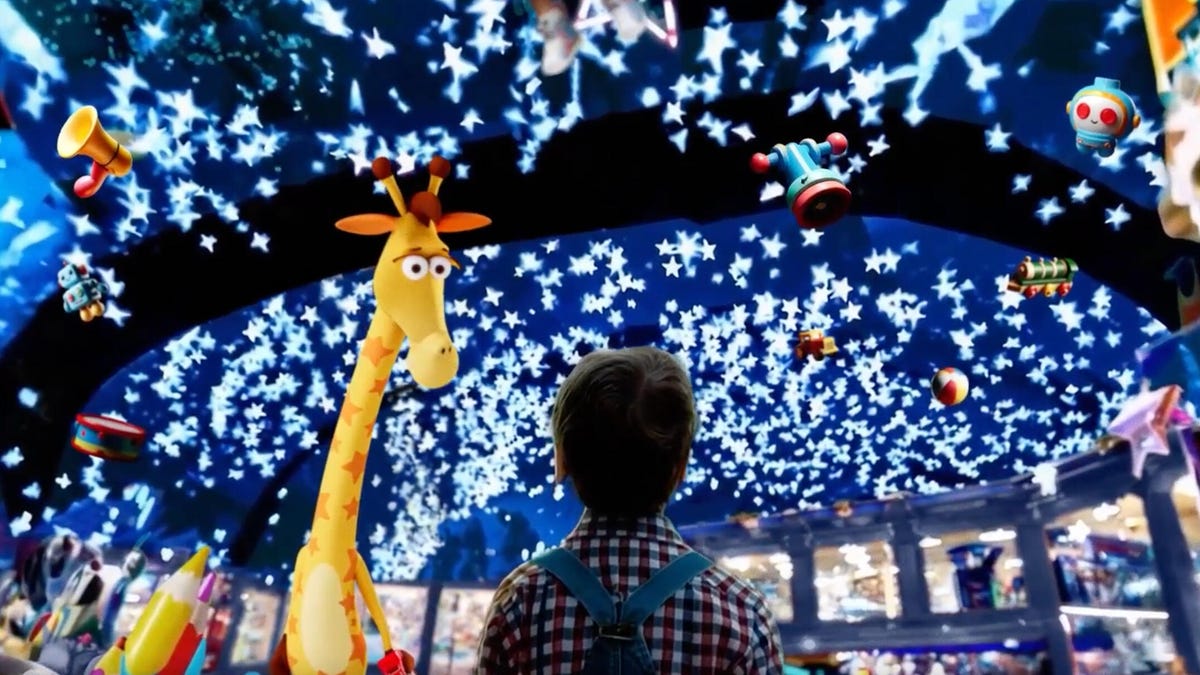
Toys “R” Us released a video made with a new artificial intelligence tool at the Cannes Film Festival on Monday, but not everyone wants to be a Toys “R” Us-AI kid. The toy retailer said in a statement that this was the first brand video created using Sora, which is a text-to-video tool from ChatGPT creator OpenAI. Sora isn’t yet available publicly, but the company was given special early access.
The 1-minute AI-generated video shows a young boy representing Charles Lazarus, the late founder of Toys “R” Us. He falls asleep and wakes in a dream world filled with toys of all types, including an animated version of store mascot Geoffrey the Giraffe. A wistful version of the store’s I Wanna Be a Toys ‘R’ Us Kid jingle plays, and a photograph of the real Lazarus posing with a costume version of Geoffrey is shown.
A teaser was released on YouTube, but you need to go to the Toys “R” Us Studios site to watch the full video.
Toys “R” Us closed its last US stores in 2021 but later opened toy departments inside of Macy’s department stores, keeping the nostalgic name alive.
But some now-grown Toys “R” Us kids weren’t comfortable with their childhood icon diving into the world of artificial intelligence.
More than 9,500 people liked a tweet on X from writer and comedian Mike Drucker, who wrote, “Love (that) this commercial is like, ‘Toys R Us started with the dream of a little boy who wanted to share his imagination with the world.’ And to show how, we fired our artists and dried Lake Superior using a server farm to generate what that would look like in Stephen King’s nightmares.”
Videos, music and dialogue using AI continue to stir controversy in the entertainment world, with concerns ranging from fears of AI replacing human workers to how easy it is to pass off AI images or sounds as real. Sometimes the reaction to AI is positive, as in 2023, when former Beatle Paul McCartney said an AI program was used to pull the late John Lennon’s voice off an old tape to make what’s been called the final Beatles song.
But last month, Sony Music Group and its affiliates spoke out against the use of music from its artists to train AI systems. A song that used AI to mimic singers Drake and The Weeknd was submitted for two Grammy Awards in 2023, forcing the musical academy to hastily set rules regarding AI and its awards. And singer Taylor Swift and President Joe Biden are among those who’ve had their voices imitated by people trying to scam others. Every new venture into the world of AI brings more questions, it seems, and with a brand name as well-known as Toys “R” Us, backlash seemed inevitable.
‘We weren’t going to hire a giraffe’
When asked by NBC News about criticisms about the potential of AI to replace human workers, Toys “R” Us Studios President Kim Miller Olko said there was a lot of “fear out there” about AI. Miller Olko said about a dozen humans worked on the video over three months, the same amount of people that would work on a non-AI job.
“Geoffrey is an animation. He’s a cartoon,” Miller Olko told NBC. “We weren’t going to hire a giraffe, you know what I mean? This was an animation.”
Representatives for Toys “R” Us and OpenAI didn’t immediately respond to requests for comment.
What is Sora?
“Sora” means sky in Japanese, and as CNET’s Connie Guglielmo wrote in February, the AI tool has earned attention for the photorealistic videos it can create.
“Sora is able to generate complex scenes with multiple characters, specific types of motion, and accurate details of the subject and background,” the company says on its site. “The model understands not only what the user has asked for in the prompt, but also how those things exist in the physical world.”
Open AI also says on its site that the company is building tools to help detect misleading content, such as a detection classifier that can tell when a video was generated by Sora, and plans to include C2PA metadata to indicate that Sora was used in an OpenAI product.
For more news, tips and reviews on artificial intelligence, check out CNET’s AI Atlas hub.
Editors’ note: CNET used an AI engine to help create several dozen stories, which are labeled accordingly. The note you’re reading is attached to articles that deal substantively with the topic of AI but are created entirely by our expert editors and writers. For more, see our AI policy.